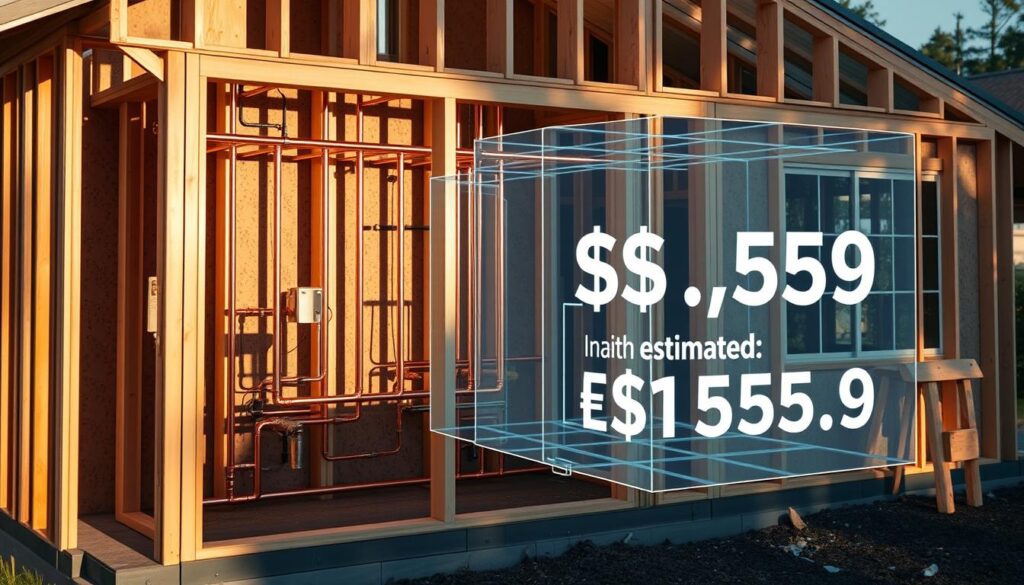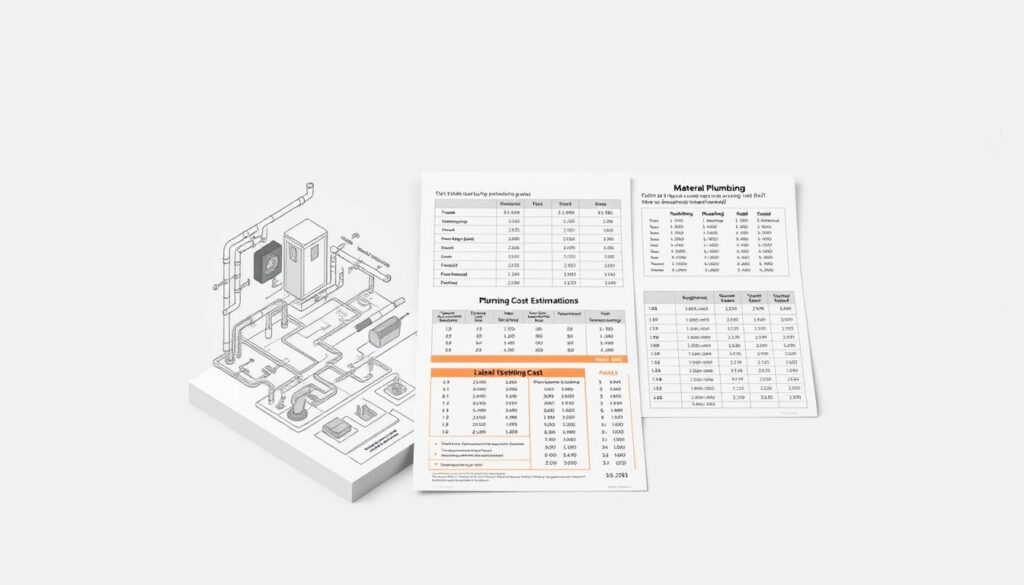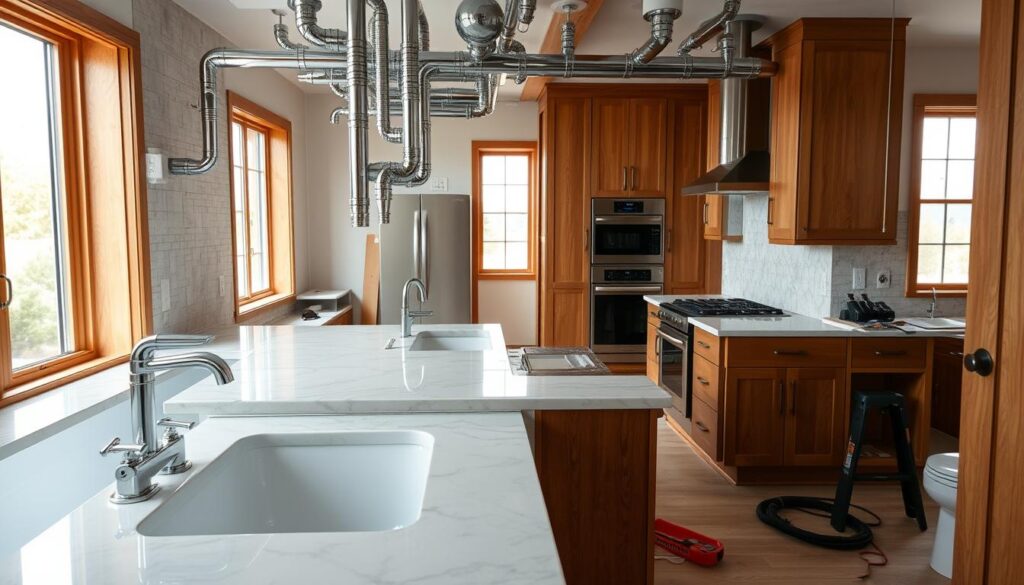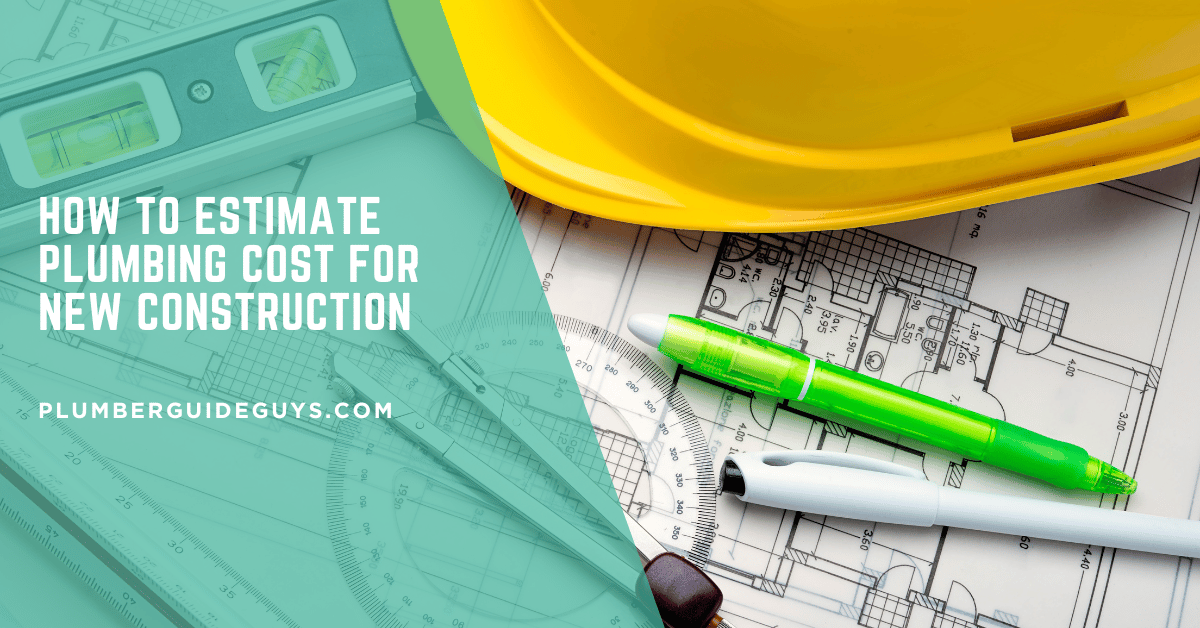Affiliate Disclosure
Plumber Guide Guys is a participant in the Amazon Services LLC Associates Program, an affiliate advertising program designed to provide a means for sites to earn advertising fees by advertising and linking to Amazon.
How to Estimate Plumbing Cost for New Construction? Did you know plumbing can take up to 15% of your new construction budget? It’s key for homeowners and contractors to know how to estimate plumbing costs. This helps avoid unexpected expenses and saves money.

Plumbing cost calculators show that for a 2,000-square-foot home, costs range from $12,000 to $20,000. These prices cover the plumbing setup, fixture installation, and the basic systems for water and waste.
Understanding plumbing costs is complex. Your total cost depends on many things like material quality, labor rates, home size, and local rules. By looking at these factors, you can make a more accurate budget for your project.
Key Takeaways
- Plumbing typically represents 15% of total construction budget
- Average plumbing costs range from $12,000 to $20,000
- Accurate estimation requires understanding multiple cost factors
- Material and labor choices significantly impact overall expenses
- Professional consultation can help refine cost projections
Table of Contents
Understanding Basic Plumbing Cost Components
When planning a new construction project, knowing the costs of plumbing is key. The cost of plumbing includes many parts that can change your total project cost.
Understanding plumbing costs requires a detailed look. You must consider several important factors that affect the total cost:
- Material quality and selection
- Labor rates and expertise
- Permit and inspection requirements
- Project complexity and scope
Material Costs and Quality Grades
The materials you choose greatly affect the cost. Different pipes have different prices and qualities:
- Copper Piping: Durable but expensive ($3-$8 per linear foot)
- PEX Tubing: A more affordable option ($0.40-$0.50 per linear foot)
- Stainless steel and other specialty materials
Labor Rate Variations
Plumbing labor costs can change for several reasons. Skilled workers usually charge between $50-$150 per hour. Rates can vary based on:
- Where you are
- The worker’s skill level
- The project’s complexity
- The time of year
Permit and Inspection Fees
Local laws need specific permits for plumbing work. These fees are usually between $50 to $500. Make sure to include these costs in your budget to avoid surprises.
Square Footage Pricing Fundamentals
When planning your new home plumbing budget, it’s key to understand square footage pricing. Contractors use the home’s total square footage to estimate plumbing costs. This makes budgeting easier.
Plumbing for new homes usually costs between $4.50 and $5.50 per square foot. For a 2,000-square-foot home, plumbing could cost between $9,000 and $11,000. Several factors affect these prices:
- Home size and layout complexity
- Number of bathrooms and fixtures
- Pipe material selection
- Local labor rates
Your plumbing budget will depend on your home’s design. Larger homes with many bathrooms or complex plumbing systems cost more. Plumbers consider these when setting prices:
- Total linear feet of piping needed
- Fixture installation complexity
- Water heater and main line connections
- Local building code requirements
Pro tip: Always get multiple quotes and discuss your specific home design to get the most accurate plumbing cost estimate.
Remember to add 10-15% to your initial estimate for unexpected costs or design changes during construction.
Material Selection and Cost Implications
Choosing the right materials is key to your plumbing budget. Knowing how to estimate costs helps you pick quality without breaking the bank.
PEX vs Copper Piping Comparison
What you choose for your pipes matters a lot. PEX and copper pipes have their own benefits:
- PEX Piping:
- Costs $0.30 to $0.82 per linear foot
- Flexible and easy to install
- Resistant to freezing and corrosion
- Copper Piping:
- Ranges from $1 to $3 per linear foot
- Traditionally durable
- Longer lifespan but more expensive
Fixture Quality and Price Ranges
What you pick for fixtures greatly affects your budget. Prices vary a lot depending on quality and features:
- Toilets: $100 to $1,000
- Sinks: $50 to $500
- Shower fixtures: $100 to $800
Installation Materials and Accessories
Don’t forget about extra costs. Fittings, valves, and accessories can add 10-20% to your total. Planning ahead can help avoid surprises.
How to Estimate Plumbing Cost for New Construction
Planning and strategic calculations are key to estimating plumbing costs for new construction. A detailed plumbing cost calculator is essential for homeowners and contractors. It helps figure out the exact costs for your project. Knowing the important factors can save a lot of money during construction.

To get an accurate plumbing cost estimate, consider these important elements:
- Total square footage of the building
- Number of bathrooms and fixtures
- Piping material selection
- Local labor rates
- Permit and inspection fees
Your plumbing cost calculator should have all the project details. Professional estimates usually fall between $8,000 to $12,000 for rough-in plumbing in a 2,000-square-foot home. You’ll also need an extra $4,000 for fixture installation.
| Project Size | Estimated Plumbing Cost | Fixture Installation |
|---|---|---|
| 1,500 sq ft | $6,000 – $9,000 | $3,000 |
| 2,000 sq ft | $8,000 – $12,000 | $4,000 |
| 2,500 sq ft | $10,000 – $15,000 | $5,000 |
For a precise plumbing cost calculator, get quotes from several contractors. Also, check local building codes and plan for unexpected costs. Always add 10-15% to your budget for emergencies to stay financially flexible.
Labor Cost Considerations and Calculations
Understanding labor costs in plumbing is key. The cost of installing plumbing can change a lot. This depends on several important factors that affect your budget.
Plumbers usually charge in two ways: by the hour or a flat rate. Both methods have benefits for homeowners looking at plumbing costs.
Hourly Rates vs Flat Rate Pricing
Knowing how plumbers price their work helps you decide. They charge between $50 and $150 an hour. This rate can change based on their experience and the job’s complexity.
- Hourly rates are clear for complex jobs
- Flat-rate pricing means you know the total cost
- Some jobs might need a mix of both pricing
Regional Labor Market Variations
Where you live affects plumbing costs. Cities with higher costs of living have pricier labor. This is different from rural areas.
| Region | Average Hourly Rate | Cost Impact |
|---|---|---|
| Northeast | $85-$125 | High |
| Midwest | $65-$95 | Medium |
| Southwest | $55-$85 | Low |
Specialty Work Surcharges
Some plumbing jobs need special skills, which cost more. Tasks like detailed pipe repairs or using unique materials can raise your bill.
“Expertise comes at a premium, but quality workmanship prevents future costly repairs.” – Professional Plumbing Association
Ask for detailed estimates and talk about extra charges before starting. This helps avoid surprise costs later.
Bathroom and Kitchen Installation Costs

Bathroom and kitchen installations are big deals in new construction. They need the most complex plumbing work. This can greatly affect your overall plumbing costs.
Bathroom plumbing costs usually fall between $1,500 and $3,000. Several things affect this:
- Fixture quality and complexity
- Total bathroom square footage
- Number of plumbing fixtures
- Local labor rates
Kitchen plumbing costs are often higher, averaging $1,700 to $4,000. This is due to specific design needs and appliance connections.
| Plumbing Area | Average Cost Range | Key Cost Factors |
|---|---|---|
| Bathroom | $1,500 – $3,000 | Toilet, shower, sink installations |
| Kitchen | $1,700 – $4,000 | Sink, dishwasher, refrigerator connections |
To get better plumbing estimates, try these tips:
- Choose standard fixture setups
- Keep piping routes simple
- Pick mid-range quality fixtures
- Work with skilled plumbing contractors
Planning wisely can help manage plumbing costs well. This ensures quality and stays within budget.
Understanding Rough-In Plumbing Expenses
Rough-in plumbing is a key part of building a new home. It sets up the plumbing system before walls are finished and fixtures are added. This stage is vital for your plumbing budget.
For a 2,000-square-foot home, rough-in plumbing costs $8,000 to $12,000. It makes up 60-70% of the plumbing costs. This is a big part of your home’s setup.
Material Requirements for Rough-In Plumbing
Several important items are needed for rough-in plumbing:
- Pipe systems (PEX or copper)
- Drainage pipes
- Vent stack materials
- Pipe supports and hangers
- Sealants and connectors
Time Estimation Guidelines
Professionals usually finish rough-in work in 3-5 days for a standard home. The time needed can vary based on:
- Home size
- Complexity of the floor plan
- Number of bathrooms and fixtures
- Local building codes
Common Challenges and Solutions
Homeowners might face issues like:
- Unexpected structural obstacles – Need flexible routes and redesigns
- Code compliance issues – Need precise measurements and expert help
- Material compatibility – Require careful pipe and connector choices
Experienced professionals can help solve these problems. They ensure a smooth plumbing setup.
Permit Requirements and Associated Costs
When you start a new construction project, understanding plumbing permits is key. Knowing the costs helps you plan your budget better. These permits make sure your plumbing follows local codes and is safe.
When you’re making plumbing estimates for new construction, remember to include permit costs. These costs can change a lot based on where you are and the size of your project. Usually, plumbing permits cost between $50 and $500 for homes.
- Contact your local building department early in the planning process
- Obtain detailed information about specific permit requirements
- Budget for possible multiple inspection fees
- Understand local code compliance requirements
Important things to think about when getting permits include:
- Detailed project plans and documentation
- Specific measurements and pipe layout
- Materials being used in the installation
- Estimated project timeline
Professional plumbers usually take care of getting permits for you. This can make things easier and avoid problems. They know the local rules and can help you avoid mistakes that could slow down your project.
Pro tip: Always include permit costs in your initial budget to prevent unexpected financial surprises during your new construction project.
Creating Accurate Cost Contingencies
Planning your construction plumbing cost breakdown is key. Unexpected challenges can quickly derail your budget. That’s why contingency planning is critical for successful home plumbing installations.
Experts say to set aside 10-15% of your total new home plumbing budget for surprises. This buffer helps manage unforeseen complications that might emerge during installation.
- Identify risk factors in your plumbing project
- Calculate realistic contingency amounts
- Understand common unexpected expenses
- Create a flexible financial strategy
Your contingency fund should cover issues like:
- Outdated infrastructure discoveries
- Unexpected material price changes
- Complex site-specific challenges
- Necessary code compliance upgrades
Proactive planning prevents financial stress. Anticipating complications in your construction plumbing cost breakdown protects you from big budget overruns. It ensures smoother project execution.
Smart homeowners always plan for the unexpected in their plumbing projects.
When allocating your contingency funds, think about your plumbing installation’s complexity. Older homes or complex designs might need a bigger financial buffer. This is compared to straightforward new construction projects.
Conclusion
Figuring out plumbing costs for new buildings needs careful planning. Knowing what affects your budget helps you avoid surprises. This way, you can plan your finances well and work efficiently.
Using a plumbing cost calculator is helpful. But, remember, the more details you put in, the more accurate your estimates will be. Include material quality, labor costs, and any unexpected issues that might come up.
With the tips from this guide, you can tackle your project with confidence. Doing your homework, getting quotes from different contractors, and understanding costs are key. Also, talking to local experts can give you specific advice for your project.
Managing plumbing costs starts with good planning and knowledge. By using the strategies we talked about, you can make smart choices. This balances quality, cost, and performance in your new building.
FAQ
How much does plumbing typically cost in new construction?
What are the most significant factors affecting plumbing installation costs?
Should I choose PEX or copper piping for my new construction?
How much does plumbing typically cost in new construction?
What are the most significant factors affecting plumbing installation costs?
Should I choose PEX or copper piping for my new construction?
FAQ
How much does plumbing typically cost in new construction?
Plumbing for new homes usually costs between .50 and .50 per square foot. The total cost can range from ,000 to ,000. This depends on your home’s size, how complex it is, and the materials you choose.
Things like the size of your home, the quality of fixtures, and local labor rates also affect the price.
What are the most significant factors affecting plumbing installation costs?
Several factors greatly impact plumbing costs. These include your home’s size, the quality of materials, and the fixtures you pick. Labor rates and local permit needs are also important.
The complexity of your plumbing system and any special installation needs matter too. The layout of your bathrooms and kitchens also plays a role.
Should I choose PEX or copper piping for my new construction?
Both PEX and copper piping have their advantages and disadvantages. PEX is cheaper, more flexible, and easier to install. It costs between
FAQ
How much does plumbing typically cost in new construction?
Plumbing for new homes usually costs between $4.50 and $8.50 per square foot. The total cost can range from $7,000 to $15,000. This depends on your home’s size, how complex it is, and the materials you choose.
Things like the size of your home, the quality of fixtures, and local labor rates also affect the price.
What are the most significant factors affecting plumbing installation costs?
Several factors greatly impact plumbing costs. These include your home’s size, the quality of materials, and the fixtures you pick. Labor rates and local permit needs are also important.
The complexity of your plumbing system and any special installation needs matter too. The layout of your bathrooms and kitchens also plays a role.
Should I choose PEX or copper piping for my new construction?
Both PEX and copper piping have their advantages and disadvantages. PEX is cheaper, more flexible, and easier to install. It costs between $0.50 and $2 per foot.
Copper piping is more durable and traditional but costs between $2 and $4 per foot. Your choice should be based on your budget, local building codes, and what you expect in the long run.
How can I accurately estimate plumbing costs for my new home?
To estimate plumbing costs accurately, start by measuring your home’s square footage. Then, research local labor rates and get quotes from licensed plumbers.
Consider the quality of materials and factor in permit fees. It’s also wise to have a 10-20% contingency budget for unexpected costs. Online plumbing cost calculators can give you a starting point.
What are typical plumbing costs for bathrooms and kitchens?
Plumbing for bathrooms usually costs between $1,500 and $5,000 per bathroom. This depends on the quality of fixtures and how complex it is. Kitchen plumbing can cost between $2,000 and $6,000, including connections for sinks and appliances.
Using luxury fixtures or having complex layouts can increase these costs.
How do permit and inspection costs impact my plumbing budget?
Permit and inspection costs can range from $500 to $2,000. These costs vary by location and project complexity. They are necessary to ensure your plumbing meets local building codes.
Always include these costs in your initial budget to avoid surprises.
What unexpected costs should I budget for in plumbing installation?
Unexpected costs can include structural changes, outdated infrastructure upgrades, and additional materials. Complex site conditions and code compliance requirements can also add to the cost.
It’s wise to have a 10-20% contingency budget for these unexpected expenses.
How do labor costs vary for plumbing installation?
Plumbing labor rates can range from $45 to $200 per hour. This depends on the plumber’s experience, location, and the project’s complexity. Some plumbers offer flat-rate pricing for specific jobs.
Urban areas and regions with higher living costs tend to have higher labor rates than rural areas.
What is rough-in plumbing, and how much does it cost?
Rough-in plumbing is the initial step of installing pipes and connections before adding fixtures. It costs between $2,000 and $5,000, depending on your home’s size and complexity.
This phase involves running water supply and drain lines through walls and floors before the final installation.
Can I reduce plumbing costs in new construction?
Yes, you can reduce plumbing costs by planning your home’s layout carefully. Choose mid-range fixtures and use cost-effective materials like PEX piping.
Getting multiple quotes, scheduling during off-peak seasons, and minimizing complex pipe routing can also help. But never sacrifice quality or code compliance to save money.
How can I accurately estimate plumbing costs for my new home?
What are typical plumbing costs for bathrooms and kitchens?
FAQ
How much does plumbing typically cost in new construction?
Plumbing for new homes usually costs between .50 and .50 per square foot. The total cost can range from ,000 to ,000. This depends on your home’s size, how complex it is, and the materials you choose.
Things like the size of your home, the quality of fixtures, and local labor rates also affect the price.
What are the most significant factors affecting plumbing installation costs?
Several factors greatly impact plumbing costs. These include your home’s size, the quality of materials, and the fixtures you pick. Labor rates and local permit needs are also important.
The complexity of your plumbing system and any special installation needs matter too. The layout of your bathrooms and kitchens also plays a role.
Should I choose PEX or copper piping for my new construction?
Both PEX and copper piping have their advantages and disadvantages. PEX is cheaper, more flexible, and easier to install. It costs between
FAQ
How much does plumbing typically cost in new construction?
Plumbing for new homes usually costs between $4.50 and $8.50 per square foot. The total cost can range from $7,000 to $15,000. This depends on your home’s size, how complex it is, and the materials you choose.
Things like the size of your home, the quality of fixtures, and local labor rates also affect the price.
What are the most significant factors affecting plumbing installation costs?
Several factors greatly impact plumbing costs. These include your home’s size, the quality of materials, and the fixtures you pick. Labor rates and local permit needs are also important.
The complexity of your plumbing system and any special installation needs matter too. The layout of your bathrooms and kitchens also plays a role.
Should I choose PEX or copper piping for my new construction?
Both PEX and copper piping have their advantages and disadvantages. PEX is cheaper, more flexible, and easier to install. It costs between $0.50 and $2 per foot.
Copper piping is more durable and traditional but costs between $2 and $4 per foot. Your choice should be based on your budget, local building codes, and what you expect in the long run.
How can I accurately estimate plumbing costs for my new home?
To estimate plumbing costs accurately, start by measuring your home’s square footage. Then, research local labor rates and get quotes from licensed plumbers.
Consider the quality of materials and factor in permit fees. It’s also wise to have a 10-20% contingency budget for unexpected costs. Online plumbing cost calculators can give you a starting point.
What are typical plumbing costs for bathrooms and kitchens?
Plumbing for bathrooms usually costs between $1,500 and $5,000 per bathroom. This depends on the quality of fixtures and how complex it is. Kitchen plumbing can cost between $2,000 and $6,000, including connections for sinks and appliances.
Using luxury fixtures or having complex layouts can increase these costs.
How do permit and inspection costs impact my plumbing budget?
Permit and inspection costs can range from $500 to $2,000. These costs vary by location and project complexity. They are necessary to ensure your plumbing meets local building codes.
Always include these costs in your initial budget to avoid surprises.
What unexpected costs should I budget for in plumbing installation?
Unexpected costs can include structural changes, outdated infrastructure upgrades, and additional materials. Complex site conditions and code compliance requirements can also add to the cost.
It’s wise to have a 10-20% contingency budget for these unexpected expenses.
How do labor costs vary for plumbing installation?
Plumbing labor rates can range from $45 to $200 per hour. This depends on the plumber’s experience, location, and the project’s complexity. Some plumbers offer flat-rate pricing for specific jobs.
Urban areas and regions with higher living costs tend to have higher labor rates than rural areas.
What is rough-in plumbing, and how much does it cost?
Rough-in plumbing is the initial step of installing pipes and connections before adding fixtures. It costs between $2,000 and $5,000, depending on your home’s size and complexity.
This phase involves running water supply and drain lines through walls and floors before the final installation.
Can I reduce plumbing costs in new construction?
Yes, you can reduce plumbing costs by planning your home’s layout carefully. Choose mid-range fixtures and use cost-effective materials like PEX piping.
Getting multiple quotes, scheduling during off-peak seasons, and minimizing complex pipe routing can also help. But never sacrifice quality or code compliance to save money.
How do permit and inspection costs impact my plumbing budget?
What unexpected costs should I budget for in plumbing installation?
How do labor costs vary for plumbing installation?
What is rough-in plumbing, and how much does it cost?
Can I reduce plumbing costs in new construction?
.50 and per foot.
Copper piping is more durable and traditional but costs between and per foot. Your choice should be based on your budget, local building codes, and what you expect in the long run.
How can I accurately estimate plumbing costs for my new home?
To estimate plumbing costs accurately, start by measuring your home’s square footage. Then, research local labor rates and get quotes from licensed plumbers.
Consider the quality of materials and factor in permit fees. It’s also wise to have a 10-20% contingency budget for unexpected costs. Online plumbing cost calculators can give you a starting point.
What are typical plumbing costs for bathrooms and kitchens?
Plumbing for bathrooms usually costs between
FAQ
How much does plumbing typically cost in new construction?
Plumbing for new homes usually costs between $4.50 and $8.50 per square foot. The total cost can range from $7,000 to $15,000. This depends on your home’s size, how complex it is, and the materials you choose.
Things like the size of your home, the quality of fixtures, and local labor rates also affect the price.
What are the most significant factors affecting plumbing installation costs?
Several factors greatly impact plumbing costs. These include your home’s size, the quality of materials, and the fixtures you pick. Labor rates and local permit needs are also important.
The complexity of your plumbing system and any special installation needs matter too. The layout of your bathrooms and kitchens also plays a role.
Should I choose PEX or copper piping for my new construction?
Both PEX and copper piping have their advantages and disadvantages. PEX is cheaper, more flexible, and easier to install. It costs between $0.50 and $2 per foot.
Copper piping is more durable and traditional but costs between $2 and $4 per foot. Your choice should be based on your budget, local building codes, and what you expect in the long run.
How can I accurately estimate plumbing costs for my new home?
To estimate plumbing costs accurately, start by measuring your home’s square footage. Then, research local labor rates and get quotes from licensed plumbers.
Consider the quality of materials and factor in permit fees. It’s also wise to have a 10-20% contingency budget for unexpected costs. Online plumbing cost calculators can give you a starting point.
What are typical plumbing costs for bathrooms and kitchens?
Plumbing for bathrooms usually costs between $1,500 and $5,000 per bathroom. This depends on the quality of fixtures and how complex it is. Kitchen plumbing can cost between $2,000 and $6,000, including connections for sinks and appliances.
Using luxury fixtures or having complex layouts can increase these costs.
How do permit and inspection costs impact my plumbing budget?
Permit and inspection costs can range from $500 to $2,000. These costs vary by location and project complexity. They are necessary to ensure your plumbing meets local building codes.
Always include these costs in your initial budget to avoid surprises.
What unexpected costs should I budget for in plumbing installation?
Unexpected costs can include structural changes, outdated infrastructure upgrades, and additional materials. Complex site conditions and code compliance requirements can also add to the cost.
It’s wise to have a 10-20% contingency budget for these unexpected expenses.
How do labor costs vary for plumbing installation?
Plumbing labor rates can range from $45 to $200 per hour. This depends on the plumber’s experience, location, and the project’s complexity. Some plumbers offer flat-rate pricing for specific jobs.
Urban areas and regions with higher living costs tend to have higher labor rates than rural areas.
What is rough-in plumbing, and how much does it cost?
Rough-in plumbing is the initial step of installing pipes and connections before adding fixtures. It costs between $2,000 and $5,000, depending on your home’s size and complexity.
This phase involves running water supply and drain lines through walls and floors before the final installation.
Can I reduce plumbing costs in new construction?
Yes, you can reduce plumbing costs by planning your home’s layout carefully. Choose mid-range fixtures and use cost-effective materials like PEX piping.
Getting multiple quotes, scheduling during off-peak seasons, and minimizing complex pipe routing can also help. But never sacrifice quality or code compliance to save money.
,500 and ,000 per bathroom. This depends on the quality of fixtures and how complex it is. Kitchen plumbing can cost between ,000 and ,000, including connections for sinks and appliances.
Using luxury fixtures or having complex layouts can increase these costs.
How do permit and inspection costs impact my plumbing budget?
Permit and inspection costs can range from 0 to ,000. These costs vary by location and project complexity. They are necessary to ensure your plumbing meets local building codes.
Always include these costs in your initial budget to avoid surprises.
What unexpected costs should I budget for in plumbing installation?
Unexpected costs can include structural changes, outdated infrastructure upgrades, and additional materials. Complex site conditions and code compliance requirements can also add to the cost.
It’s wise to have a 10-20% contingency budget for these unexpected expenses.
How do labor costs vary for plumbing installation?
Plumbing labor rates can range from to 0 per hour. This depends on the plumber’s experience, location, and the project’s complexity. Some plumbers offer flat-rate pricing for specific jobs.
Urban areas and regions with higher living costs tend to have higher labor rates than rural areas.
What is rough-in plumbing, and how much does it cost?
Rough-in plumbing is the initial step of installing pipes and connections before adding fixtures. It costs between ,000 and ,000, depending on your home’s size and complexity.
This phase involves running water supply and drain lines through walls and floors before the final installation.
Can I reduce plumbing costs in new construction?
Yes, you can reduce plumbing costs by planning your home’s layout carefully. Choose mid-range fixtures and use cost-effective materials like PEX piping.
Getting multiple quotes, scheduling during off-peak seasons, and minimizing complex pipe routing can also help. But never sacrifice quality or code compliance to save money.

